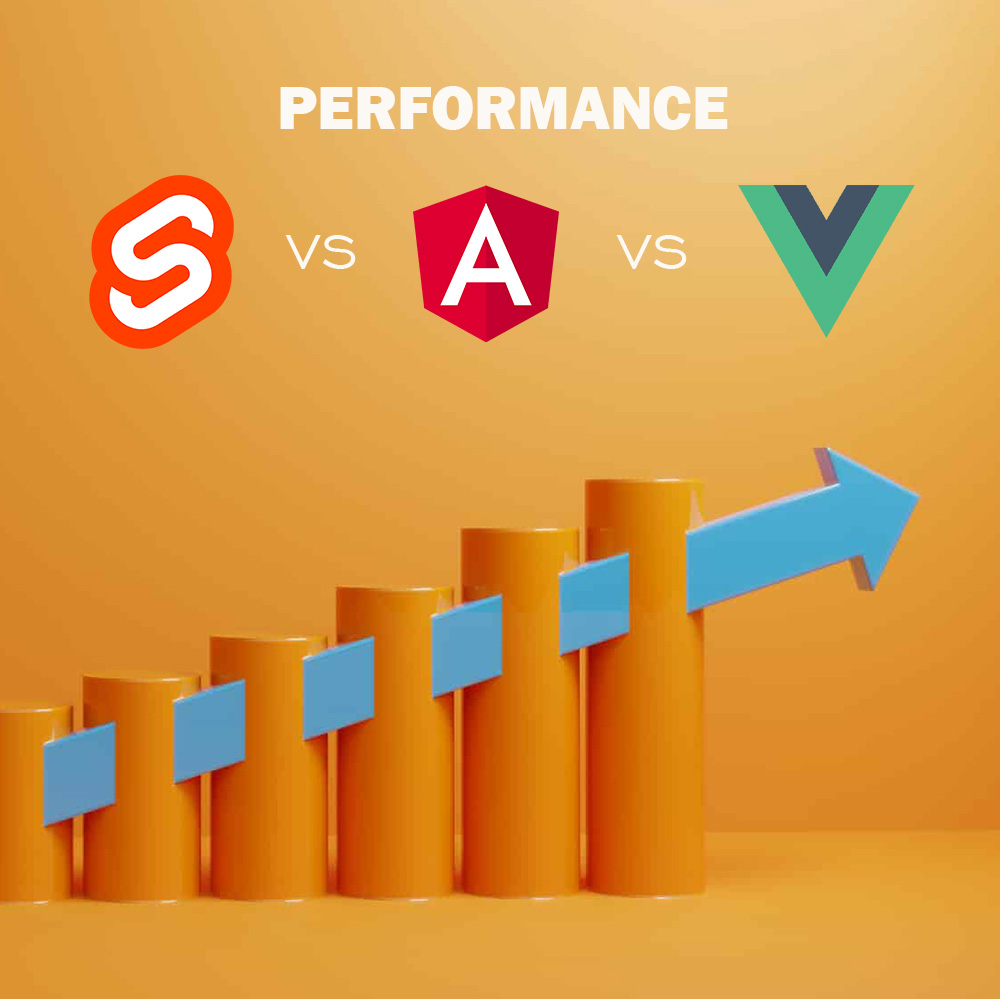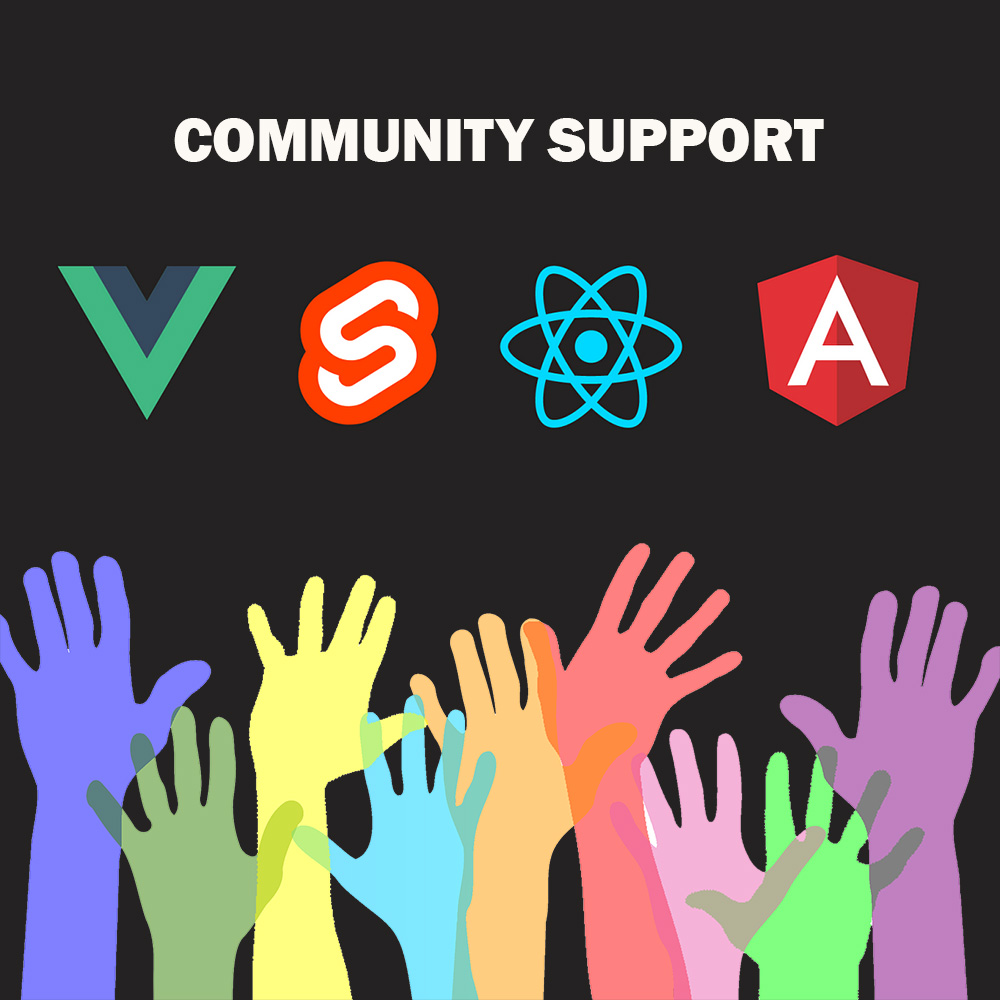Svelte vs. Angular vs. Vue
Svelte

Svelte vs. Angular vs. Vue.js: An Overview
In the fast-paced world of web development, choosing the proper framework can significantly impact work productivity and the success of your projects. Svelte, Angular, and Vue are popular JavaScript frameworks developers have widely adopted. This comprehensive comparison explores their features, advantages, and community support. Additionally, we delve into performance metrics, examining Svelte vs Vue, Angular vs Svelte, and the overall performance of Angular, React, Vue, and Svelte
In this comprehensive comparison, we will explore Svelte, Angular, and Vue, briefly overview each framework and highlight their strengths and weaknesses. You will better understand which framework best fits your needs and preferences by the end. So, let's delve into the world of Svelte, Angular, and Vue and discover what sets them apart in web development.
ALSO READ 5 Best Ways to Improve Svelte JS Applications
Core Concepts and Features : Vue vs. Angular vs. Svelte
Svelte
Svelte, a cutting-edge JavaScript framework, distinguishes itself through its unique core concepts and architecture. Svelte's core revolves around components, reactivity, and a compilation step. Components are the building blocks of Svelte applications, encapsulating HTML, CSS, and JavaScript code. Reactivity enables automatic updates to the user interface based on changes in underlying data, achieved through dependency tracking. Svelte's state management system leverages reactive assignments, simplifying the handling of application states. Underneath these concepts, Svelte employs a compilation step during the build process, optimizing performance by generating highly efficient JavaScript code.
Angular
The core concepts and architecture of Angular form the backbone of this robust JavaScript framework. Angular follows a component-based architecture, where web applications are built by combining reusable components. These components consist of HTML templates, CSS styles, and TypeScript code, clearly separating concerns. Angular employs a reactive programming model, using observables and RxJS to manage asynchronous data streams and handle events. The framework also incorporates a hierarchical dependency injection system for efficient communication and data sharing between components. Angular's architecture encompasses declarative templates, two-way data binding, and a comprehensive module system that promotes modularity and scalability.
Vue.js
Vue.js, a versatile JavaScript framework, is renowned for its core concepts and flexible architecture. At the heart of Vue.js lies its component-based approach, allowing developers to build web applications by combining reusable and self-contained components. These components consist of HTML templates, CSS styles, and JavaScript code, providing a modular structure for development. Vue.js embraces reactivity, automatically updating the user interface whenever the underlying data changes. This is made possible through a powerful observation system that tracks data dependencies.
Svelte vs. Angular vs. Vue Performance

Svelte:
Svelte takes a different approach compared to traditional frameworks like Angular and Vue. It compiles the code during the build process and generates highly optimized JavaScript code that runs directly in the browser. This compilation step allows Svelte to eliminate the need for a virtual DOM, resulting in faster initial loading times and improved runtime performance. The absence of a virtual DOM also reduces memory usage, leading to smoother animations and interactions. Overall, Svelte's performance is commendable due to its efficient rendering mechanism.
Angular:
Angular, developed by Google, is a comprehensive framework that offers powerful features for building complex applications. However, its runtime performance can be heavier than other frameworks. Angular's use of a virtual DOM introduces an additional layer of abstraction, which can impact performance, especially in large-scale applications. However, Angular mitigates this performance impact by employing a technique called "Change Detection," which optimizes the updates and only applies changes where necessary. With proper implementation and optimization, Angular can deliver good performance, especially for enterprise-level applications.
Vue:
Vue balances Svelte and Angular regarding runtime performance, often praised for its simplicity and ease of use. Vue utilizes a virtual DOM similar to Angular but employs a highly efficient update mechanism called "reactive data binding." This approach allows Vue to track changes to the data and update only the necessary components, resulting in faster rendering and improved performance. Additionally, Vue provides an option to leverage a compilation step with its Single-File Component (SFC) approach, which can further enhance performance by reducing the overhead of runtime compilation.
In terms of raw benchmark numbers, Svelte often outperforms Angular and Vue due to its compilation-based approach. However, it's important to note that the actual performance of a web application depends on various factors, including the project's complexity, the proficiency of the development team, and the optimization techniques employed.
Development Experience: Svelte vs. Angular vs. Vue :
Svelte:
Svelte is known for its simplicity and minimalistic approach to web development. Its learning curve is relatively gentle, especially for developers familiar with HTML, CSS, and JavaScript. Svelte's straightforward syntax and clear documentation make it accessible for beginners. With Svelte, there is no need to learn complex abstractions or extensive tooling setups, which streamlines the learning process. However, as Svelte takes a unique approach to component-based development, developers may need to grasp its reactive programming model and understand the reactivity concept to utilize its potential fully.
Angular:
Angular, developed by Google, is a comprehensive framework with a steeper learning curve than Svelte and Vue. Angular introduces powerful concepts like dependency injection, modules, decorators, and TypeScript. While these concepts offer robustness and maintainability, they require a significant initial investment in learning. Developers already familiar with object-oriented programming and have experience with frameworks like Java or .NET may find Angular more approachable. However, for those new to web development or coming from a different framework, Angular's learning curve can be challenging initially.
Vue:
Vue, often praised for its simplicity and ease of use, strikes a balance between Svelte and Angular in terms of the learning curve. Vue's documentation is considered one of the best in the industry, providing clear explanations and examples. Its gentle learning curve makes it suitable for both beginners and experienced developers. Vue leverages familiar concepts from HTML, CSS, and JavaScript, allowing developers to grasp its core concepts quickly. Additionally, Vue's gradual adoption strategy enables developers to integrate it into existing projects or adopt it incrementally, further easing the learning process.
It's important to note that the learning curve for each framework is subjective and can vary depending on an individual's prior experience and familiarity with related technologies. Developers already well-versed in JavaScript and have experience with other frameworks may find it easier to transition to a new one. The availability of learning resources, tutorials, and community support can also impact the learning curve.
Angular vs. React vs. Vue vs. Svelte : Community Support

Svelte:
While Svelte is a relatively newer framework than Angular and Vue, it has gained significant popularity and an enthusiastic and growing community. The official Svelte website offers extensive documentation, tutorials, and examples, making it easy for developers to start. Additionally, the community-driven ecosystem surrounding Svelte has been expanding rapidly, with the availability of various libraries, tools, and frameworks that integrate seamlessly with Svelte. Although the ecosystem may not be as mature as those of Angular or Vue, the active community ensures continuous growth and improvement.
Angular:
Angular, developed and maintained by Google, boasts a robust ecosystem and a large, active community. With Google's backing, Angular enjoys strong community support, frequent updates, and comprehensive documentation. The Angular community is known for its extensive knowledge sharing through forums, online communities, and conferences. The ecosystem offers various third-party libraries, plugins, and tools, enabling developers to enhance their Angular applications. The ecosystem's maturity and the community's strong support make Angular a solid choice for enterprise-level projects.
Vue:
Vue has gained significant popularity in recent years thanks to its simplicity, ease of use, and dedicated and passionate community. Vue's official documentation is considered one of the best in the industry, providing comprehensive guides and examples. The Vue community is highly active and supportive, with numerous online forums, meetups, and conferences where developers can connect and share their knowledge. The Vue ecosystem is robust, offering a plethora of libraries, plugins, and tools to extend Vue applications. The availability of official and community-driven resources ensures that developers have access to the support they need.
When considering community support and the ecosystem, it's important to evaluate factors such as the availability of learning resources, the frequency of updates, the responsiveness of the community to issues and questions, and the ecosystem's overall health. While Svelte may have a smaller community than Angular and Vue, it is a rapidly growing ecosystem with enthusiastic contributors. Angular, backed by Google, provides a mature and comprehensive ecosystem suitable for large-scale projects. Vue combines simplicity and a thriving community, offering a balanced ecosystem for developers.
Analysis of the Component-Based Architecture

Svelte:
Svelte embraces a unique approach to component-based architecture. In Svelte, components are written in a single file, combining HTML, CSS, and JavaScript concisely and intuitively. Svelte components are reactive by default, meaning component data changes automatically trigger DOM updates. This approach eliminates the need for a virtual DOM and reduces the overhead of runtime calculations. Svelte's component-based architecture promotes code reusability and encapsulation, allowing developers to build self-contained components that can be quickly composed and shared across projects.
Angular:
Angular's component-based architecture is at the core of its framework. Angular enforces a strict separation of concerns, where components handle the UI logic while services manage the data and business logic. Components in Angular are defined using TypeScript classes and HTML templates, promoting a structured and organized approach to development. Angular's component-based architecture facilitates hierarchical component composition, allowing components to be nested within each other, forming a tree-like structure. This enables developers to create complex UI structures by combining smaller, reusable components. Angular's architecture also emphasizes dependency injection, allowing the components to rely on services and other dependencies, further enhancing code modularity and testability.
Vue:
Vue's component-based architecture is designed to be approachable and flexible. Vue components are defined using a combination of HTML templates, JavaScript, and CSS styles. Vue embraces a reactive data model, allowing developers to declare data properties that automatically trigger updates to the component and its child components when modified. Vue's architecture encourages component reusability and composition through various techniques, such as mixins, slots, and scoped styles. Mixins enable code reuse by allowing developers to share functionality across multiple components, while slots provide a powerful way to pass content and structure from parent components to child components. Vue's flexible architecture empowers developers to create components that suit their specific needs, whether they prefer a template-centric or programmatic approach.
Each framework's component-based architecture offers distinct advantages and suits different development styles. Svelte's approach prioritizes simplicity and performance; Angular enforces a structured and comprehensive architecture, and Vue balances flexibility and ease of use. The choice of framework and its component-based architecture should align with the project's requirements, the development team's preferences, and the desired level of control and complexity.
Overview of State Management Options

Svelte:
Svelte takes a more lightweight approach to state management than other frameworks. In Svelte, reactive declarations can manage the state within individual components. Svelte's reactivity system allows developers to define reactive variables and automatically update the feature when the state changes. This simple and intuitive approach eliminates the need for external state management libraries in many cases. However, for more complex scenarios or large-scale applications, developers may integrate third-party state management libraries like Redux or Zustand into their Svelte projects.
Angular:
Angular provides a powerful built-in state management solution known as "NgRx." NgRx is inspired by Redux, a popular state management library in JavaScript. NgRx uses a unidirectional data flow pattern, where the application state is stored in a central store and accessed by components through selectors. Actions are dispatched to modify the state, and reducers immediately handle these actions to update the store. NgRx offers features like middleware, effects, and entity management, enabling developers to manage complex state management scenarios effectively. However, NgRx has a steeper learning curve and may be more suitable for larger applications with significant state management needs.
Vue:
Vue provides a versatile and scalable state management solution called "Vuex." Flux and Redux heavily inspire Vuex and follow a similar unidirectional data flow pattern. It allows developers to define a central store to hold the application state and provides mechanisms for mutating it through mutations and actions. Vuex also supports modules, allowing developers to split the store into smaller, manageable modules. Vuex integrates seamlessly with Vue components, making it easy to access and update the state within the application. Vuex is well-documented and supported by a vibrant community, making it a popular choice for state management in Vue applications.
Each framework's state management options have strengths and are suitable for different scenarios. Svelte's built-in reactivity system provides a lightweight approach for more straightforward applications, while Angular's NgRx offers a robust solution for managing complex states in large-scale projects. Vue's Vuex balances simplicity and scalability, making it versatile for various application sizes.
Assessment of the Popularity and Adoption Trends
Svelte:
Although relatively newer than Angular and Vue, Svelte has been rapidly gaining popularity in recent years. Its unique selling point of compiling components to highly efficient JavaScript code has garnered attention from developers seeking optimal performance. Svelte's approach's simplicity and intuitive nature have attracted experienced and novice developers. Svelte's growing popularity is evident in the increasing number of GitHub stars, the growth of its community forums, and the adoption by notable companies and organizations. The framework's rising popularity suggests a strong future, with a growing ecosystem and active community support.
Angular:
Angular, developed and maintained by Google, has a long-standing presence in the web development community. While its initial adoption saw rapid growth, the framework has seen a more stable trajectory in recent years. Angular remains a popular choice, particularly for enterprise-level applications that demand scalability, robustness, and maintainability. Google's backing and extensive documentation contribute to Angular's continued popularity. The framework's adoption trends reflect its maturity and stability, with many large organizations and established projects relying on Angular as their preferred framework.
Vue:
Vue has experienced a remarkable surge in popularity in recent years and has established itself as a prominent player in the web development ecosystem. Vue's simplicity, flexibility, and gentle learning curve have appealed to developers of all skill levels. The framework's active community, which includes passionate developers and maintainers, has played a significant role in its growth. Vue's adoption trends demonstrate a steady increase in usage across various projects, from small personal websites to large-scale applications. The framework's popularity is further evident in the number of GitHub stars, npm downloads, and the adoption by well-known companies and platforms.
Also Read : Svelte.js vs. React.js: Choosing the Right Framework for Your Next Project
It's important to note that popularity and adoption trends can change over time. While Svelte is gaining traction rapidly, Angular and Vue have more established positions in the web development landscape. When assessing these frameworks ' popularity and adoption trends, developers should consider project requirements, ecosystem maturity, community support, and personal preferences.
Examination of the Limitations and Potential Drawbacks
Svelte:
- Immaturity: Svelte, a relatively newer framework compared to Angular and Vue, may have a smaller ecosystem and fewer third-party libraries. This could mean you need to write more custom code or adapt existing libraries to work with Svelte.
- Learning Curve: While Svelte's simplicity is often seen as an advantage, it may pose a challenge for developers transitioning from other frameworks. Familiarizing yourself with Svelte's reactive approach and compilation process may require some initial learning.
Angular:
- Complexity: Angular is a comprehensive framework with a steep learning curve. Its extensive feature set and complex concepts, such as dependency injection and RxJS, may take time for developers to master.
- Bundle Size: Angular applications tend to have larger bundle sizes than Svelte and Vue. This can impact initial load times and require additional optimization techniques to ensure optimal performance.
Vue:
- Scalability: While Vue is suitable for many projects, it may face challenges with large-scale applications. Managing state and performance, optimizations might require additional effort and architectural considerations.
- Standardization: Vue's flexibility can sometimes lead to inconsistent coding practices across different projects or teams. Maintaining code quality and consistency may require additional effort without enforcing strict guidelines.
It's important to note that these limitations and potential drawbacks are not absolute deal-breakers and can be mitigated with proper planning, best practices, and an understanding of the frameworks. Many developers have successfully built and maintained applications using Svelte, Angular, and Vue.
Conclusion:
In this comprehensive comparison, we have explored three popular frameworks for web development: Svelte, Angular, and Vue. Each framework has unique features, strengths, and limitations that make it suitable for different projects and development scenarios.
Selecting the right framework depends on your project's requirements, team expertise, and long-term goals. Evaluating factors such as performance, learning curve, community support, and limitations is essential before deciding. Remember, there is no one-size-fits-all solution, and the best framework for your web development needs may vary from project to project.
Keep in mind that web development is an ever-evolving field, and frameworks may evolve and improve over time. Stay updated with the latest trends, explore new features, and refine your skills to adapt to changing requirements.
By considering all these factors and aligning them with your project goals, you can confidently choose between Svelte, Angular, and Vue and embark on a successful web development journey.
Looking to build your next web application? Explore the pros and cons of Svelte, Angular, and Vue for web development in this comprehensive comparison. Discover which framework suits your project's needs best. If you need expert assistance, consider ecomstreet for reliable Svelte JS development services. Stay ahead in the competitive web development landscape with the right framework.
Faq About Svelte vs. Angular vs. Vue for Web Development
Q: What makes Svelte unique in comparison to Angular and Vue for web development?
Svelte stands out with its compilation approach, moving much work to compile time. This results in smaller runtime code, offering excellent performance and simplicity compared to Angular and Vue.
Q: How does Angular's structure differ from Vue vs Svelte, and what are its advantages?
Angular embraces a comprehensive, opinionated structure suitable for large-scale applications. Its advantages include built-in testing, TypeScript support, and a rich set of tools for robust development.
Q: In terms of performance, how do Vue vs Svelte compare to Angular for web applications?
Svelte often leads in performance due to its compilation approach, resulting in smaller bundles and faster execution. Vue strikes a balance between performance and simplicity, while Angular excels in large-scale applications
Q: Which framework, among Svelte vs Angular vs Vue, is more suitable for beginners in web development?
Vue.js is renowned for its gentle learning curve, making it particularly suitable for beginners. Its incremental adaptability allows developers to progressively adopt its features.
Q: How does the community support and ecosystem of Svelte, Angular, and Vue compare in the broader web development landscape?
A: React has a vast ecosystem and is highly popular. Angular has strong community support, especially in enterprise settings. Vue.js benefits from a thriving community and a balanced approach between simplicity and scalability. Svelte, while newer, has gained attention for its unique approach and is steadily growing in community support. Consider your project's needs and the community ecosystem when choosing a framework.

Author
Manas Singh
Designation : Sr.Full Stack Developer
Having 11+ years of experience in application development domain, now he is working on Web3 and blockchain technology. He is having sound knowledge of Solidity language and building smart contracts.